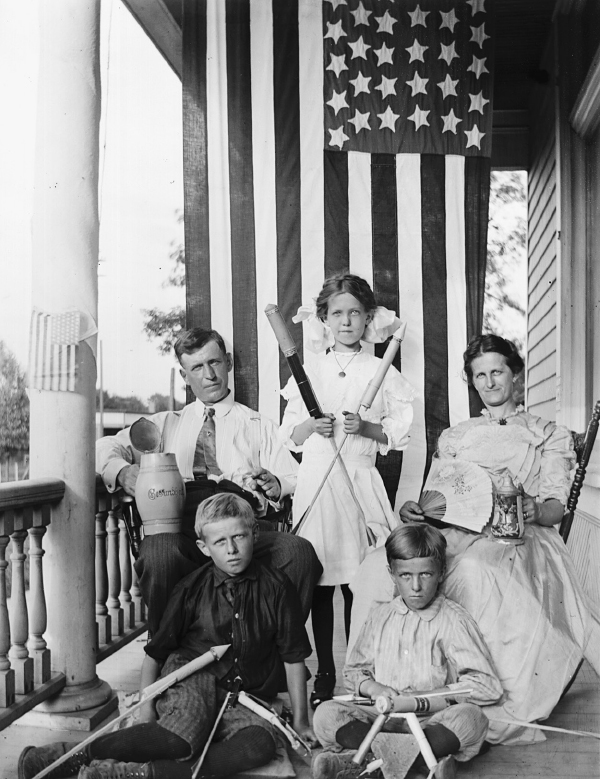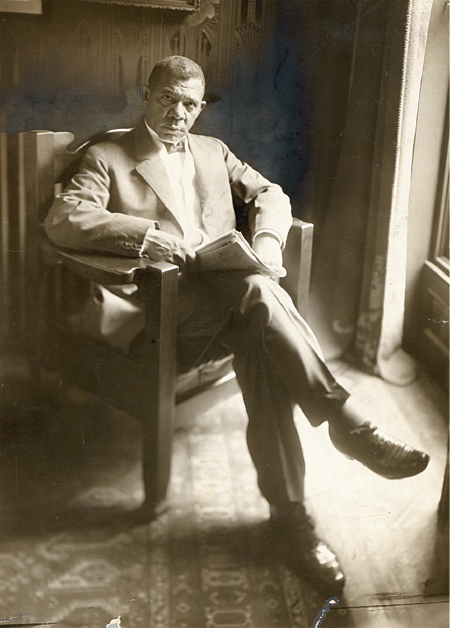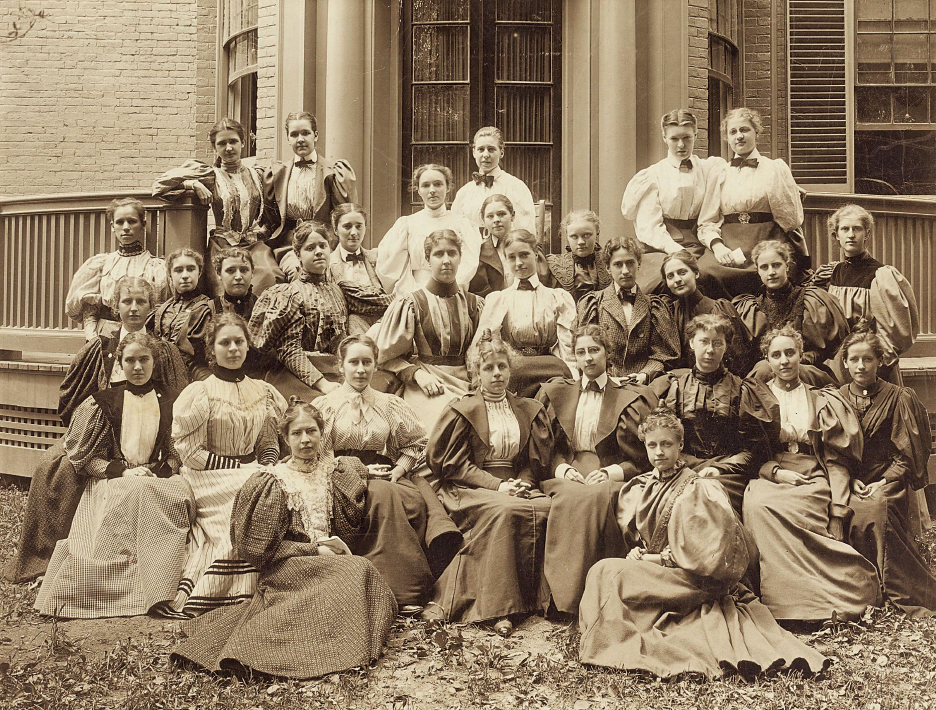America’s History: Printed Page 586
America: A Concise History: Printed Page 534
America’s History: Value Edition: Printed Page 518
Education

In the industrial economy, the watchword for young people who hoped to secure good jobs was education. A high school diploma — now a gateway to a college degree — was valuable for boys who hoped to enter professional or managerial work. Daughters attended in even larger numbers than their brothers (Table 18.1). Parents of the Civil War generation, who had witnessed the plight of war widows and orphans, encouraged girls to prepare themselves for teaching or office jobs, work before marriage, and gain skills they could fall back on, “just in case.” By 1900, 71 percent of Americans between the ages of five and eighteen attended school. That figure rose further in the early twentieth century, as public officials adopted laws requiring school attendance.
| High School Graduates, 1870–1910 | ||||
| Percent | ||||
| Year | Number | 17-Year-Olds | Male | Female |
| 1870 | 16,000 | 2.0 | 7,000 | 9,000 |
| 1890 | 44,000 | 3.0 | 19,000 | 25,000 |
| 1910 | 156,000 | 8.6 | 64,000 | 93,000 |
|
Source: Historical Statistics of the United States, 2 vols. (Washington, DC: U.S. Bureau of the Census, 1975), 1: 386. |
||||
Most high schools were coeducational, and almost every high school featured athletics. Recruited first as cheerleaders for boys’ teams, girls soon established field hockey and other sports of their own. Boys and girls engaged in friendly — and sometimes not-so-friendly — rivalry in high school. In 1884, a high school newspaper in Concord, New Hampshire, published this poem from a disgruntled boy who caricatured his female classmates:
We know many tongues of living and dead,
In science and fiction we’re very well read,
But we cannot cook meat and cannot make bread
And we’ve wished many times that we were all dead.
A female student shot back a poem of her own, denouncing male students’ smoking habit:
But if boys will smoke cigarettes
Although the smoke may choke them,
One consolation still remains —
They kill the boys that smoke them.
The rate of Americans attending college had long hovered around 2 percent; driven by public universities’ expansion, the rate rose in the 1880s, reaching 8 percent by 1920. Much larger numbers attended a growing network of business and technical schools. “GET A PLACE IN THE WORLD,” advertised one Minneapolis business college in 1907, “where your talents can be used to the best advantage.” Typically, such schools offered both day and night classes in subjects such as bookkeeping, typewriting, and shorthand.
The needs of the new economy also shaped the curriculum at more traditional collegiate institutions. State universities emphasized technical training and fed the growing professional workforce with graduates trained in fields such as engineering. Many private colleges distanced themselves from such practical pursuits; their administrators argued that students who aimed to be leaders needed broad-based knowledge. But they modernized course offerings, emphasizing French and German, for example, rather than Latin and Greek. Harvard, led by dynamic president Charles W. Eliot from 1869 to 1909, pioneered the liberal arts. Students at the all-male college chose from a range of electives, as Eliot called for classes that developed each young man’s “individual reality and creative power.”

In the South, one of the most famous educational projects was Booker T. Washington’s Tuskegee Institute, founded in 1881. Washington both taught and exemplified the goal of self-help; his autobiography, Up from Slavery (1901), became a best-seller. Because of the deep poverty in which most southern African Americans lived, Washington concluded that “book education” for most “would be almost a waste of time.” He focused instead on industrial education. Students, he argued, would “be sure of knowing how to make a living after they had left us.” Tuskegee sent female graduates into teaching and nursing; men more often entered the industrial trades or farmed by the latest scientific methods.
Washington gained national fame in 1895 with his Atlanta Compromise address, delivered at the Cotton States Exposition in Atlanta, Georgia. For the exposition’s white organizers, the racial “compromise” was inviting Washington to speak at all. It was a move intended to show racial progress in the South. Washington, in turn, delivered an address that many interpreted as approving racial segregation. Stating that African Americans had, in slavery days, “proved our loyalty to you,” he assured whites that “in our humble way, we shall stand by you … ready to lay down our lives, if need be, in defense of yours.” The races could remain socially detached: “In all things that are purely social we can be as separate as the fingers, yet one as the hand in all things essential to mutual progress.” Washington urged, however, that whites join him in working for “the highest intelligence and development of all.”
Whites greeted this address with enthusiasm, and Washington became the most prominent black leader of his generation. His soothing rhetoric and style of leadership, based on avoiding confrontation and cultivating white patronage and private influence, was well suited to the difficult years after Reconstruction. Washington believed that money was color-blind, that whites would respect economic success. He represented the ideals of millions of African Americans who hoped education and hard work would erase white prejudice. That hope proved tragically overoptimistic. As the tide of disenfranchisement and segregation rolled in, Washington would come under fire from a younger generation of race leaders who argued that he accommodated too much to white racism.
In addition to African American education, women’s higher education expanded notably. In the Northeast and South, women most often attended single-sex institutions, including teacher-training colleges. For affluent families, private colleges offered an education equivalent to men’s — for an equally high price. Vassar College started the trend when it opened in 1861; Smith, Wellesley, and others followed. Anxious doctors warned that these institutions were dangerous: intensive brain work would unsex young women and drain energy from their ovaries, leading them to bear weak children. But as thousands of women earned degrees and suffered no apparent harm, fears faded. Single-sex higher education for women spread from private to public institutions, especially in the South, where the Mississippi State College for Women (1885) led the way.
Coeducation was more prevalent in the Midwest and West, where many state universities opened their doors to female students after the Civil War. Women were also admitted to most African American colleges founded during Reconstruction. By 1910, 58 percent of America’s colleges and universities were coeducational. While students at single-sex institutions forged strong bonds with one another, women also gained benefits from learning with men. When male students were friendly, they built comfortable working relationships; when men were hostile, women learned coping skills that served them well in later employment or reform work. One doctor who studied at the University of Iowa remembered later that he and his friends mercilessly harassed the first women who entered the medical school. But when the women showed they were good students, the men’s attitudes changed to “wholesome respect.”
Whether or not they got a college education, more and more women recognized, in the words of Elizabeth Cady Stanton, their “solitude of self.” In the changing economy, they could not always count on fathers and husbands. Women who needed to support themselves could choose from dozens of guidebooks such as What Girls Can Do (1880) and How to Make Money Although a Woman (1895). The Association for the Advancement of Women, founded in 1873 by women’s college graduates, defended women’s higher education and argued that women’s paid employment was a positive good.
Today, many economists argue that education and high-quality jobs for women are keys to reducing poverty in the developing world. In the United States, that process also led to broader gains in women’s political rights. As women began to earn advanced degrees, work for wages and salaries, and live independently, it became harder to argue that women were “dependents” who did not need to vote.

TRACE CHANGE OVER TIME
Question
How did educational opportunities change after the Civil War, and for whom?